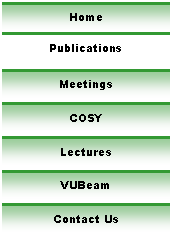
|
Reprint Server |



Evolutionary Optimization Methods for Accelerator Design
A Dissertation
In partial fulfillment of the requirements for the degree of Doctor of Philosophy from Michigan State University.
Abstract
Many problems from the fields of accelerator physics and beam theory can be formulated as optimization problems and, as such, solved using optimization methods. Despite growing efficiency of the optimization methods, the adoption of modern optimization techniques in these fields is rather limited. Evolutionary Algorithms (EAs) form a relatively new and actively developed optimization methods family. They possess many attractive features such as: ease of the implementation, modest requirements on the objective function, a good tolerance to noise, robustness, and the ability to perform a global search efficiently which make them the tool of choice for many design and optimization problems. In this work we study the application of EAs to problems from accelerator physics and beam theory. We review the most commonly used methods of unconstrained optimization and describe the GATool, evolutionary algorithm and the software package, used in this work, in detail. Then we use a set of test problems to assess its performance in terms of computational resources, quality of the obtained result, and the tradeoff between them. We justify the choice of GATool as a heuristic method to generate cutoff values for the COSY-GO rigorous global optimization package for the COSY Infinity scientific computing package. We design the model of their mutual interaction and demonstrate that the quality of the result obtained by GATool increases as the information about the search domain is refined, which supports the usefulness of this model. We discuss GATool's performance on the problems suffering from static and dynamic noise and study useful strategies of GATool parameter tuning for these and other difficult problems. We review the challenges of constrained optimization with EAs and methods commonly used to overcome them. We describe REPA, a new constrained optimization method based on repairing, in exquisite detail, including the properties of its two repairing techniques: REFIND and REPROPT. We assess REPROPT's performance on the standard constrained optimization test problems for EA with a variety of different configurations and suggest optimal default parameter values based on the results. Then we study the performance of the REPA method on the same set of test problems and compare the obtained results with those of several commonly used constrained optimization methods with EA. Based on the obtained results, particularly on the outstanding performance of REPA on test problem that presents significant difficulty for other reviewed EAs, we conclude that the proposed method is useful and competitive. We discuss REPA parameter tuning for difficult problems and critically review some of the problems from the de-facto standard test problem set for the constrained optimization with EA. In order to demonstrate the practical usefulness of the developed method, we study several different problems of accelerator design and demonstrate how they can be solved or solved faster with EAs. These problems include a simple accelerator design problem (design a quadrupole triplet to be stigmatically imaging, find all possible solutions), a complex real-life accelerator design problem (an optimization of the front end section for the future neutrino factory), and a problem of the normal form defect function optimization which is used to rigorously estimate the stability of the beam dynamics in circular accelerators. The positive results we obtained suggest that the application of EAs to problems from accelerator theory can be very beneficial and has large potential. The developed optimization scenarios and tools can be used to approach similar problems.A. Poklonskiy (2009)
Download
Click on the icon to download the corresponding file.
![]() Download Adobe PDF version (3549496 Bytes).
Download Adobe PDF version (3549496 Bytes).
Go Back to the reprint server.
Go Back to the home page.
This page is maintained by Kyoko Makino. Please contact her if there are any problems with it.